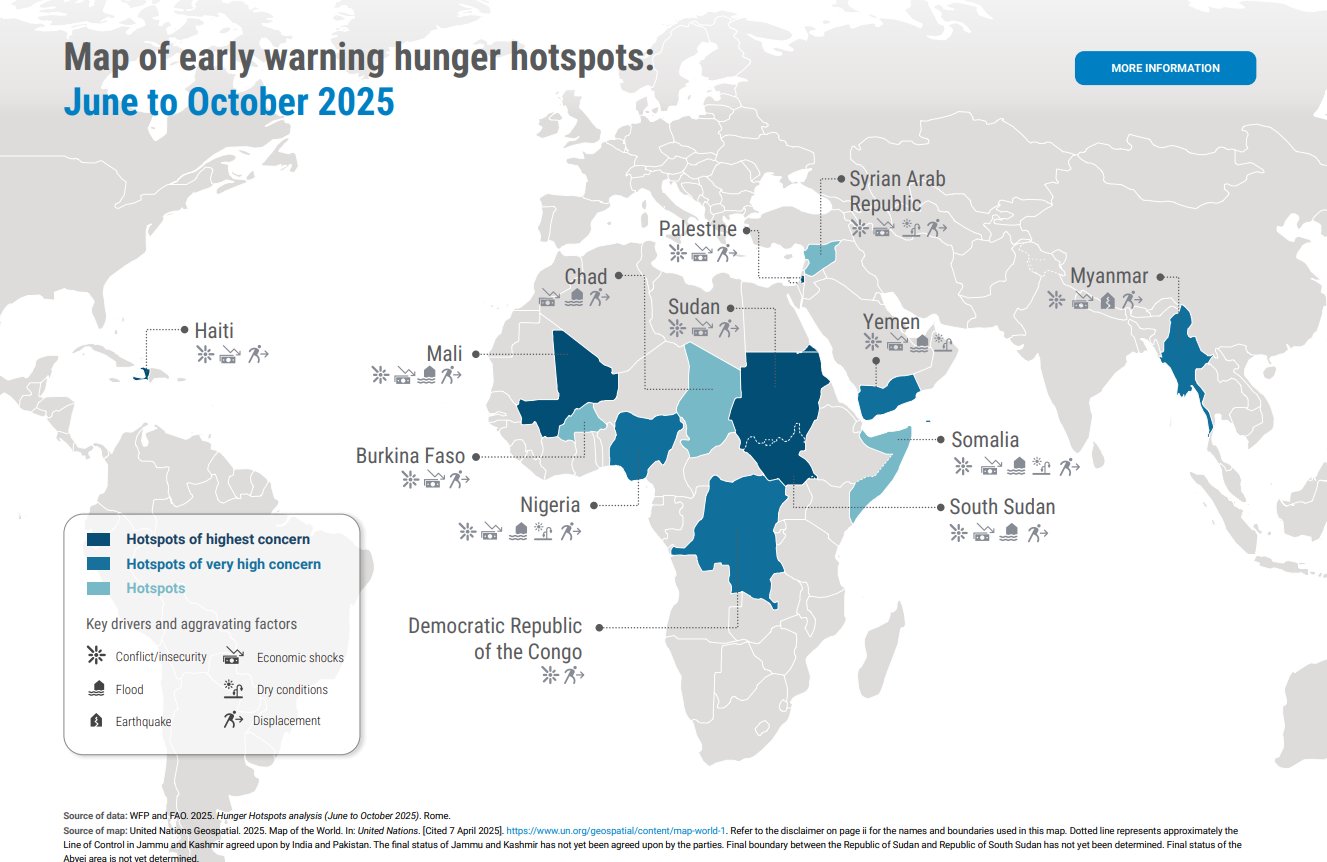A joint report released by the Food and Agriculture Organization (FAO) and the World Food Programme (WFP) on June 16, 2025, has identified five countries as global hunger hotspots of highest concern: Sudan, South Sudan, Mali, Haiti, and Palestine.
· The Hunger Hotspots: FAO-WFP Early Warning on Acute Food Insecurity report highlights conflict, economic shocks, and climate-related hazards as the primary causes behind rising hunger and starvation.
Countries at Highest Risk:
· Sudan: Still reeling from a 2024 famine, Sudan remains in crisis due to ongoing conflict and mass displacement. An estimated 24.6 million people face severe food insecurity (IPC Phase 3 or above), with 637,000 at catastrophic levels (IPC Phase 5).
· South Sudan: Between April and July 2025, nearly 7.7 million people — about 57% of the population — are projected to suffer extreme food shortages. Around 63,000 may experience famine-like conditions, triggered by floods, economic hardship, and political instability.
· Mali: Roughly 2,600 people in Mali risk starvation between June and August 2025. The crisis is driven by armed conflict and surging food prices.
· Palestine (Gaza): All 2.1 million residents of Gaza are experiencing severe food insecurity, with 500,000 at risk of famine by September 2025. Ongoing military actions and a blockade have devastated access to food.
· Haiti: Gang violence has displaced thousands in Haiti. As of now, 8,400 people are already facing catastrophic levels of hunger.
Broader Global Concerns:
- The report also highlights deteriorating conditions in 13 countries, with armed conflict being the primary driver in 12 of them. Countries of significant concern include Yemen, the Democratic Republic of the Congo (DRC), Myanmar, and Nigeria. The DRC has re-entered the list due to escalating violence, while Nigeria faces the added challenge of adverse weather in 2025.
- Other critical hotspots include Burkina Faso, Chad, Somalia, and Syria. Conversely, some nations — including Ethiopia, Kenya, Mozambique, Zimbabwe, and Lebanon — have shown temporary improvements, largely due to better harvests and reduced military conflict. However, these gains remain fragile.
Key Drivers of Food Insecurity:
1. Conflict and Political Instability: Armed violence disrupts farming, destroys infrastructure, and displaces populations, severely reducing food availability.
2. Economic Shocks: Inflation, declining purchasing power, and weak social safety nets are making food inaccessible for millions.
3. Climate Shocks: Droughts, floods, and erratic weather patterns are damaging crops and livelihoods. The ongoing La Niña event is expected to worsen drought in parts of East Africa.
4. Disruption of Access: Humanitarian aid is often unable to reach conflict zones due to access restrictions and infrastructure damage.
Recommendations for Action:
- Enhance Humanitarian Access: Negotiate access in conflict zones and improve logistics infrastructure to support aid distribution.
- Strengthen Early Warning Systems: Use real-time data on weather, market trends, and conflict to act before crises escalate.
- Promote Climate-Resilient Agriculture: Support drought-resistant crops, improved irrigation, and soil conservation.
- Support Economic Access to Food: Expand social protection, stabilize prices, and improve market access for vulnerable communities.
- Foster Peacebuilding Efforts: Address root causes of conflict through mediation, governance support, and local peacebuilding.
- Ensure Nutrition-Focused Aid: Include maternal and child nutrition, food fortification, and dietary education in response plans.
- Build Local Capacities: Empower community organisations and local institutions for sustainable and inclusive food security responses.
The report calls for immediate global attention and coordinated action to prevent famine and build long-term food resilience in the most vulnerable regions.







